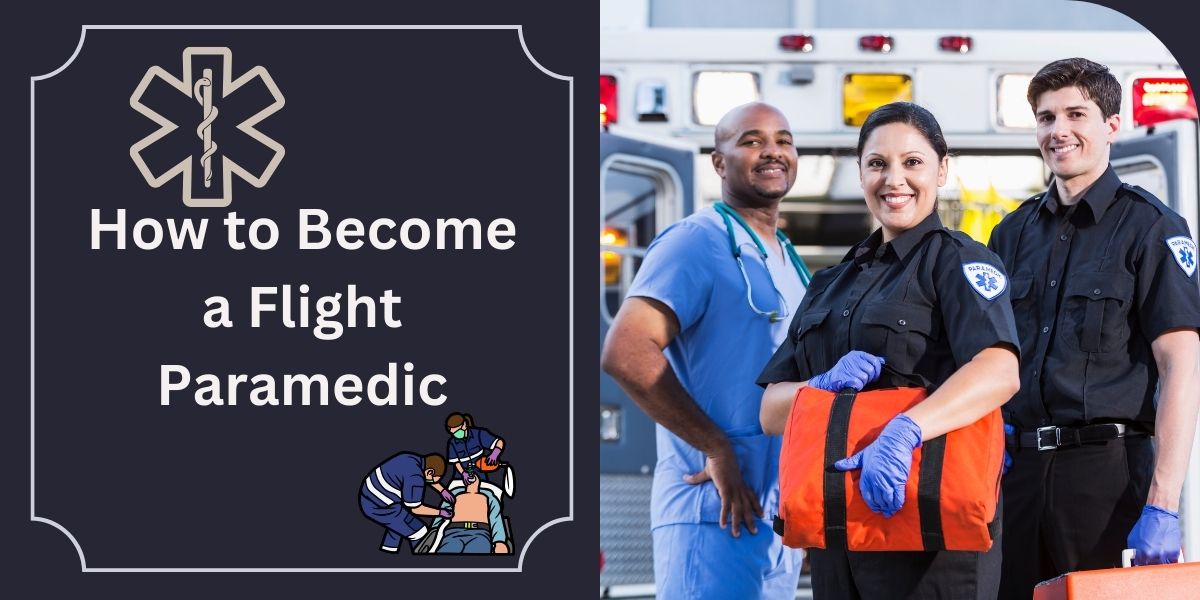Embarking on the path to becoming a flight paramedic is a thrilling pursuit for those passionate about merging medical expertise with high-flying adventures.
No one knows what kind of emergency can happen on a flight, which is why airlines have flight paramedics on each flight to ensure that passengers receive emergency care if something were to happen.
Flight paramedics have an essential role in the medical industry, often working in situations that are time-sensitive and critical. In this article, we will discuss how to become a flight paramedic, important skills, and salary.
Who is a flight paramedic?
A flight paramedic, also called a flight medic or air medic, is an emergency medical professional who provides clinical aid to people in difficult-to-access locations. For most flight medics, helicopters serve as the principal transportation method because they allow pilots to maneuver quickly in cramped spaces.
As a subclass of emergency medical technicians (EMTs) or paramedics, flight medics perform a similar task to those medical professionals, like providing care to patients being transported to a hospital.
Because helicopters fly at low altitudes during rescue missions, their profession poses a greater risk than that of an ambulatory EMT or paramedic.
What does a flight paramedic do?
Similar to a traditional paramedic, most of a flight medic’s job responsibilities involve providing patients with emergency medical care, like treating serious injuries and slowing the progress of illnesses.
In this role, flight paramedics leverage the helicopters’ capabilities to perform air evacuations and stabilize patients as they’re being transported to hospitals.
They also work closely with flight nurses—these professionals are often a common pairing for emergency rescue missions. The flight medic may also perform other duties, such as:
- Treating a patient’s injuries and wounds at the site of the accident
- Administering injections, IV drips and medications to patients
- Maintaining an adequate supply of medical inventory, medicines, and lifesaving equipment
- Ensuring that tools for first-aid procedures are in working condition
- Communicating with medical control centers and on-call physicians during emergency patient treatments
- Performing a variety of specialized medical procedures, like general anesthetics, paralytics, intubation, and the management of ventilators
- Assessing the condition of patients
- Ensuring the safety of crew members during emergency operations
How to Become a Flight Paramedic
Follow these steps to help you become a flight paramedic:
1. Complete a paramedic training program
To become a flight paramedic, you need to complete a paramedic training program that lasts a little under a year. Some schools also offer associate degrees in paramedics, which last about two years. Training programs can vary, but most of them include basic classes such as:
- CPR
- Life support
- Critical care
- Trauma
- Anatomy
Programs also usually include a clinical portion in which you gain practical experience in paramedicine.
2. Get a paramedic/EMT license
After completing a program, the next step is to become licensed. You can get the EMT personnel license through your state’s public health department or another public health institution, though states may have their own specific requirements for getting the license.
This license generally lasts for two to four years, after which you need to become re-certified. Recertification parameters may also vary from state to state, so it’s important to understand your state’s requirements as you plan your career.
3. Work as a ground paramedic or EMT
Though the requirements to become a flight paramedic vary depending on the employer, most organizations require that you work as a lead paramedic in a high-volume emergency medical service ground facility for three to five years.
High-volume facilities handle a large number of emergencies daily, which can provide many opportunities to practice skills relevant to being a flight medic.
To gain leadership experience, it’s important to consult with your team leaders and supervisors to determine what options are available to you. Volunteering for more responsibility may also help you gain this experience.
4. Pursue additional certifications
There are many medical certifications you can pursue as an aspiring flight medic. These certifications can help you expand your medical skill set, handle high-stress trauma environments, and increase your appeal as a flight medic to employers. Some certifications to consider include:
- Basic Life Support (BLS) certification
- Advanced Cardiac Life Support certification
- Pediatric Advanced Life Support certification
- Pre-Hospital Trauma Life Support certification
5. Take the flight paramedic exams
Getting the flight paramedic certification requires taking two exams: the cognitive exam and the psychomotor exam.
The cognitive exam tests your knowledge of the core EMT practices and principles taught in a paramedic/EMT training program. It focuses on subjects like cardiology, medicine, trauma, airways, and obstetrics and gynecology services.
The psychomotor exam seeks to determine the practical application of your knowledge and learning. For this exam, you should be able to:
- Examine a scene for all the important details
- Perform resuscitation actions
- Retrieve the history of a patient
- Make an additional assessment of the situation and the patient
- Read and interpret an ECG reading
- Maintain cardiac conditions like arrhythmia and cardiac arrest
- Demonstrate communication skills
6. Get additional flight certifications
Before finding work as a flight paramedic, it may be a requirement to take additional flight certifications, like aerospace medical or medical transportation safety professional certifications.
Some employers allow new flight paramedics to get their certifications after they begin working in the field. There are many flight certifications available, so thorough research can help you identify which ones would support your personal career goals as a flight medic.
Skills to Become a Flight Paramedic
A successful flight A paramedic needs several essential skills for their role. They generally have an expansive knowledge of emergency medical practices and procedures, including a firm understanding of medicines and how to administer them properly.
Because of the unpredictable nature of their work, they also learn about the safety regulations and policies to follow when out in the field.
Flight paramedics apply critical-thinking skills to make prompt decisions in high-pressure situations with no significant amount of supervision.
Communication, teamwork, and interpersonal skills help them work efficiently with their team members and comfort patients during crises. Because flying is such a vital element of the job, they mustn’t be fearful of heights or easily affected by motion sickness.
Additional skills for flight medics include:
- Resource management
- Attention to detail
- Risk assessment
- Flexibility
- Adaptability
- Medical technology knowledge
- Time management
How much does a flight paramedic make?
As of January 22, 2024, the average annual pay for a flight paramedic in the United States is $67,524 a year.
Just in case you need a simple salary calculator, that works out to be approximately $32.46 an hour. This is the equivalent of $1,298/week or $5,627/month.
While ZipRecruiter is seeing annual salaries as high as $100,000 and as low as $29,000, the majority of flight paramedic salaries currently range between $55,000 (25th percentile) and $74,500 (75th percentile), with top earners (90th percentile) making $96,000 annually across the United States.
The average pay range for a flight paramedic varies greatly (by as much as $19,500), which suggests there may be many opportunities for advancement and increased pay based on skill level, location, and years of experience.
Conclusion
A flight paramedic is a highly trained and skilled medical professional who provides critical care to patients during air transport, often in helicopters or fixed-wing aircraft.
These professionals play a crucial role in aeromedical teams, combining their paramedic expertise with the challenges of providing emergency medical care in a high-altitude and dynamic environment.
Once grounded in paramedic basics, set your sights on additional certifications specific to air medical transport. If you want to get hired in the aviation industry, active engagement in ongoing training and staying abreast of medical advancements ensures you’re well-prepared for the dynamic role of a flight paramedic.




 Jobi.ng
Jobi.ng



